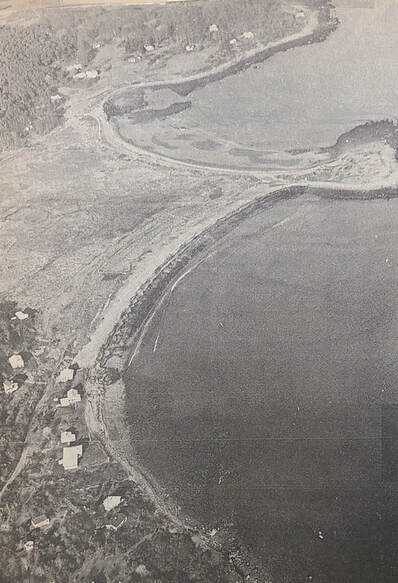The History of Kittery
Kittery has the distinction of being the oldest town in the State of Maine, incorporated in 1647 - more than a century and a quarter before the birth of the United States. The following historical highlights are provided from the Maine Bicentennial Edition of “A Brief History of Kittery, Maine”, published by the Kittery Historical and Naval Society.
 Before Europeans arrived around 1600, Indigenous people lived here for thousands of years without a written history. Archaeology in southern Maine has indicated population shifts from environmental changes and human interaction across the region. When Europeans landed, the Indigenous here lived in scattered villages. The Indigenous people had dome-shaped wigwams frames covered by birch bark or matting, clothes made from animal hides and they made ceramic pottery for containers. As hunter-gatherers, they relied on fish and seals, moose and deer, and plants for food. By the 1600's, they also grew corn, beans, and squash. They likely used birch bark canoes, rather than dugouts. They traded, and warred with other tribes in present-day Canada and across New England. In the early 1600’s, this area was visited by European explorers and then fisherman, who were based at the Isles of Shoals. Kittery was named by its English settlers, more than likely after Kittery Court, a manor house, and Kittery Point, on the River Dart in Kingswear, Devon, England. Kittery was settled by 1623; and the first house built in 1635.
Before Europeans arrived around 1600, Indigenous people lived here for thousands of years without a written history. Archaeology in southern Maine has indicated population shifts from environmental changes and human interaction across the region. When Europeans landed, the Indigenous here lived in scattered villages. The Indigenous people had dome-shaped wigwams frames covered by birch bark or matting, clothes made from animal hides and they made ceramic pottery for containers. As hunter-gatherers, they relied on fish and seals, moose and deer, and plants for food. By the 1600's, they also grew corn, beans, and squash. They likely used birch bark canoes, rather than dugouts. They traded, and warred with other tribes in present-day Canada and across New England. In the early 1600’s, this area was visited by European explorers and then fisherman, who were based at the Isles of Shoals. Kittery was named by its English settlers, more than likely after Kittery Court, a manor house, and Kittery Point, on the River Dart in Kingswear, Devon, England. Kittery was settled by 1623; and the first house built in 1635.
The Town of Kittery was incorporated in 1647, making it the oldest town in Maine. It had three parishes: Lower (Kittery), Middle (Eliot) until 1810, and Upper (Berwick) until 1713. The three parishes split up before Maine became a state. In 1652, Kittery and York agreed to submit to the Massachusetts Bay Colony. The Province of Maine stayed a part of Massachusetts from then until 1820. That fact is why Maine celebrates Patriot’s Day in April, to this day.
Kittery, like the coastal towns of Bath, Belfast, Thomaston and Waldoboro, became an early center for shipbuilding. During the American Revolution, a 32-gun frigate, Raleigh, was built here and served from 1776 to 1783. An 18-gun sloop, Ranger, was also built in Kittery in 1777 for John Paul Jones to command. The Ranger was the first warship to fly the new American flag. Ships were built on Badger’s Island by William Badger in the late 1700’s and by his nephew, Samuel Bager in the early 1800s.
The Portsmouth Naval Shipyard (PNSY) was established in 1800, when the U.S. Government purchased Fernald’s Island in the Piscataqua River between Kittery and Portsmouth. In 1825, a bridge was built from Kittery to PNSY. In 1826, PNSY expanded to Seavey’s Island. From the War of 1812, until after World War II, PNSY was engaged in ship construction. Naval vessels, from wooden frigates through iron-clad warships to nuclear submarines, have all been worked on at PNSY for more than two centuries. Today, PNSY still has a vital role in the U.S. Navy.
In 1820, Maine became a state, as part of the Missouri Compromise. The following years, from 1820 to 1860 were boom times for Maine. The state’s population doubled, numerous ships were built, fish were abundant, shipping and trade grew and agriculture prospered. In the late 1800’s, Kittery earned a place in the arts. The best known of its writers was Celia Thaxter,
whose works include the poem “Sandpiper” and an 1873 book, “Among the Isles of Shoals”. Later, in 1888, Rice Public Library opened, with a bequest from Arabella Rice.
In 1905, two landmark events made Portsmouth famous around the world, although both events occurred in Kittery. In July, the largest man-made explosion to date in history caused Henderson’s Point on Seavey’s Island to disappear. This altered the swift current of the Piscataqua River, making it less treacherous. Two months later, in September, the Treaty of Portsmouth was signed at the Portsmouth Naval Shipyard, ending the Russo-Japanese War. Delegates from both countries spent the summer here negotiating at the invitation of President Theodore Roosevelt.
The advent of automobiles in the 1900’s led to numerous changes in the Kittery landscape. The local trolley ceased operations suddenly in 1923. In 1923, the Memorial Bridge opened, linking Kittery with Portsmouth, connecting Route 1 between the states, and ending ferry service.
Over the years, Kittery’s industry and business have emphasized fishing, shipbuilding, trading, hospitality, retail and the arts. The “Gateway to Maine” welcomes visitors from around the U.S. and the world. For over three centuries, Kittery has managed to grow and prosper, while still preserving its New England charm. The town’s rich heritage reaches back to the earliest days of the country. Kittery’s story is part of America’s story.
Additional Reading
 Before Europeans arrived around 1600, Indigenous people lived here for thousands of years without a written history. Archaeology in southern Maine has indicated population shifts from environmental changes and human interaction across the region. When Europeans landed, the Indigenous here lived in scattered villages. The Indigenous people had dome-shaped wigwams frames covered by birch bark or matting, clothes made from animal hides and they made ceramic pottery for containers. As hunter-gatherers, they relied on fish and seals, moose and deer, and plants for food. By the 1600's, they also grew corn, beans, and squash. They likely used birch bark canoes, rather than dugouts. They traded, and warred with other tribes in present-day Canada and across New England. In the early 1600’s, this area was visited by European explorers and then fisherman, who were based at the Isles of Shoals. Kittery was named by its English settlers, more than likely after Kittery Court, a manor house, and Kittery Point, on the River Dart in Kingswear, Devon, England. Kittery was settled by 1623; and the first house built in 1635.
Before Europeans arrived around 1600, Indigenous people lived here for thousands of years without a written history. Archaeology in southern Maine has indicated population shifts from environmental changes and human interaction across the region. When Europeans landed, the Indigenous here lived in scattered villages. The Indigenous people had dome-shaped wigwams frames covered by birch bark or matting, clothes made from animal hides and they made ceramic pottery for containers. As hunter-gatherers, they relied on fish and seals, moose and deer, and plants for food. By the 1600's, they also grew corn, beans, and squash. They likely used birch bark canoes, rather than dugouts. They traded, and warred with other tribes in present-day Canada and across New England. In the early 1600’s, this area was visited by European explorers and then fisherman, who were based at the Isles of Shoals. Kittery was named by its English settlers, more than likely after Kittery Court, a manor house, and Kittery Point, on the River Dart in Kingswear, Devon, England. Kittery was settled by 1623; and the first house built in 1635. The Town of Kittery was incorporated in 1647, making it the oldest town in Maine. It had three parishes: Lower (Kittery), Middle (Eliot) until 1810, and Upper (Berwick) until 1713. The three parishes split up before Maine became a state. In 1652, Kittery and York agreed to submit to the Massachusetts Bay Colony. The Province of Maine stayed a part of Massachusetts from then until 1820. That fact is why Maine celebrates Patriot’s Day in April, to this day.
Kittery, like the coastal towns of Bath, Belfast, Thomaston and Waldoboro, became an early center for shipbuilding. During the American Revolution, a 32-gun frigate, Raleigh, was built here and served from 1776 to 1783. An 18-gun sloop, Ranger, was also built in Kittery in 1777 for John Paul Jones to command. The Ranger was the first warship to fly the new American flag. Ships were built on Badger’s Island by William Badger in the late 1700’s and by his nephew, Samuel Bager in the early 1800s.
The Portsmouth Naval Shipyard (PNSY) was established in 1800, when the U.S. Government purchased Fernald’s Island in the Piscataqua River between Kittery and Portsmouth. In 1825, a bridge was built from Kittery to PNSY. In 1826, PNSY expanded to Seavey’s Island. From the War of 1812, until after World War II, PNSY was engaged in ship construction. Naval vessels, from wooden frigates through iron-clad warships to nuclear submarines, have all been worked on at PNSY for more than two centuries. Today, PNSY still has a vital role in the U.S. Navy.
In 1820, Maine became a state, as part of the Missouri Compromise. The following years, from 1820 to 1860 were boom times for Maine. The state’s population doubled, numerous ships were built, fish were abundant, shipping and trade grew and agriculture prospered. In the late 1800’s, Kittery earned a place in the arts. The best known of its writers was Celia Thaxter,
whose works include the poem “Sandpiper” and an 1873 book, “Among the Isles of Shoals”. Later, in 1888, Rice Public Library opened, with a bequest from Arabella Rice.
In 1905, two landmark events made Portsmouth famous around the world, although both events occurred in Kittery. In July, the largest man-made explosion to date in history caused Henderson’s Point on Seavey’s Island to disappear. This altered the swift current of the Piscataqua River, making it less treacherous. Two months later, in September, the Treaty of Portsmouth was signed at the Portsmouth Naval Shipyard, ending the Russo-Japanese War. Delegates from both countries spent the summer here negotiating at the invitation of President Theodore Roosevelt.
The advent of automobiles in the 1900’s led to numerous changes in the Kittery landscape. The local trolley ceased operations suddenly in 1923. In 1923, the Memorial Bridge opened, linking Kittery with Portsmouth, connecting Route 1 between the states, and ending ferry service.
Over the years, Kittery’s industry and business have emphasized fishing, shipbuilding, trading, hospitality, retail and the arts. The “Gateway to Maine” welcomes visitors from around the U.S. and the world. For over three centuries, Kittery has managed to grow and prosper, while still preserving its New England charm. The town’s rich heritage reaches back to the earliest days of the country. Kittery’s story is part of America’s story.
Additional Reading
- To read the full “A Brief History of Kittery, Maine” booklet, published by the Kittery Historical and Naval Society, please click here.
- For more information on the Kittery Historical and Naval Museum, including hours, exhibits and additional links, please click here.
- To access the Museum’s database of people from Kittery’s history, which includes biographical sketches, burial locations throughout Kittery’s 140 cemeteries and more, please click here.


